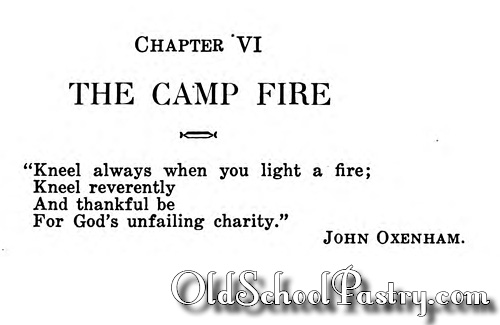1927 Original S’mores Recipe and Methods for a Campfire
My girls are going away to camp this summer, which typically inspires s’mores at home before and after the trip. There is something about the crisp graham cracker, caramelized marshmallow, and softly melted chocolate that makes you want more than one. The original recipe for S’mores can be traced back to the Girl Scout handbook, Tramping and Trailing With the Girl Scouts, published in 1927.

"Some More" Original S'more Girl Scout Recipe
Equipment
- 8 sticks
Ingredients
- 16 graham crackers
- 8 bars plain chocolate (any of the good plain brands broken in two)
- 16 marshmallows
Instructions
- Toast two marshmallows over the coals to a crisp gooey state and then put them inside a graham cracker and chocolate par sandwich. The heat of the marshmallow between the halves of chocolate bar will melt the chocolate a bit. Though it tastes like "some more" one is really enough.
Campfire Safety
Included in this handbook are 5 different campfires to build, with tips for starting them and why they are useful at camp: Windy Day Fire; Wigwam Fire; Criss-Cross Fire; Hunter’s Fire; Fire in a Hole; Reflector Baking Fire; Council Fire; Backlog Fire; Stone or Sod Fireplace; Open Trench Fire; Indian’s or Star Fire; and Bean Hole.

Below is the advice given to all campers, and it is real good advice for today’s campers, too. Know your surroundings, prepare it correctly, never leave a fire once it is started, extinguish it completely when finished, and always – safety first.
Dancing flames, fairies in the fire, pictures in the coals – the camp fire brings a new understanding of the folk tales and of literature of the peoples of the earth. For fire has always been a symbol to man, greatly feared and greatly loved. All races in their infancy have worshiped at sacred fires, and from its ancient significance as the first great element man domesticated and used, it grew to be the symbol of spirituality, of purity and of faith. We come naturally by our love of the camp fire- perhaps it was the finest luxury of our ancestors.
Although the camp fire is bright and cheerful, and pleasant the smell of wood-smoke at twilight, Brother Fire is also mighty and strong and sometimes cruel. He needs a firm hand trained to keep him in his place as a friend rather than an enemy of mankind.
So first, last and in between times, be careful how and where you build your fire, stay with it until you have finished with it, and WHEN YOU LEAVE BE SURE THAT YOU HAVE PUT IT OUT.
Prepare a safe area for the fire by clearing away all inflammable material – dry grass, leaves, pine needles, and twigs, from a space from six to ten feet in diameter. If it is a dry season, or if there is a high wind , drench the outer edge of the space with water. If the water is inadequate, dig a trench or erect a rock barrier around the cleared space, or dig up the sod and line the fireplace with rocks. The sod should be replaced after the fire has been extinguished and the ground cooled. Build the fire in an open space if possible, never against a tree or decayed log. Pine, eucalyptus, and many other trees are inflammable, and even trees which are not apt to ignite may have their foliage killed by rising heat.
Do not build a fire unless you have at hand the means for putting it out completely. When you have finished with your camp fire you can extinguish it by drenching it with water. If the water supply is inadequate, separate the charred sticks, cover every sign of the fire with sand or soil that is free from any inflammable material and then stamp it down solidly. Never go away from a fire even for a short time and leave it burning. If the troop wants to start cooking and then go down to the brook or climb the hill or pick berries, one or two girls must be left to watch the fire. And if you decide to have a fire burning all night you must arrange watches of one or two hours each to guard it.
Let “Safety First” be your watchword while building and tending a camp fire. For if you are careless enough to forget it, you many not only lose you own equipment, but also cause great loss of property to other – even loss of life.
You must be logged in to post a comment.